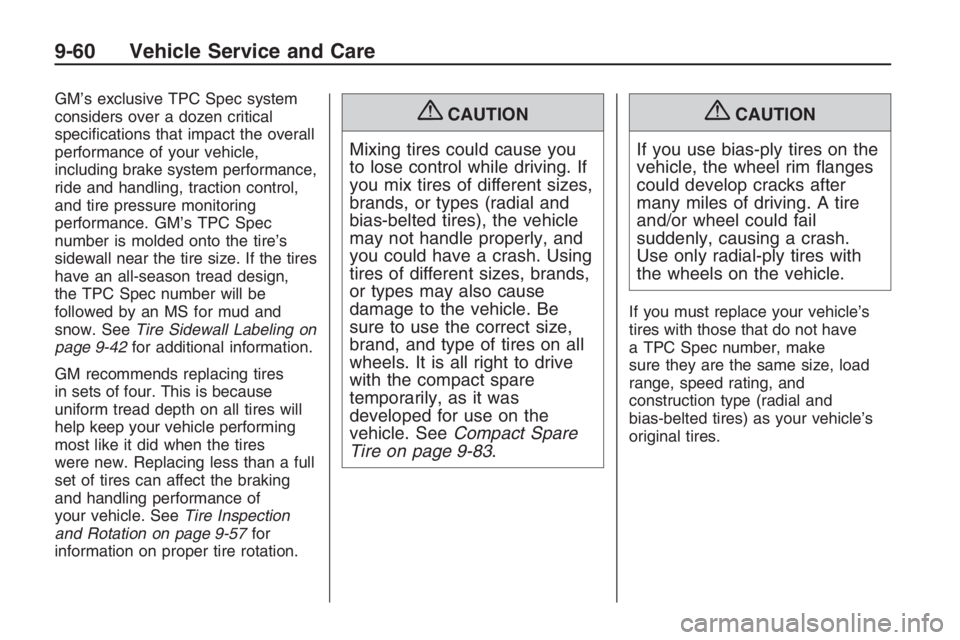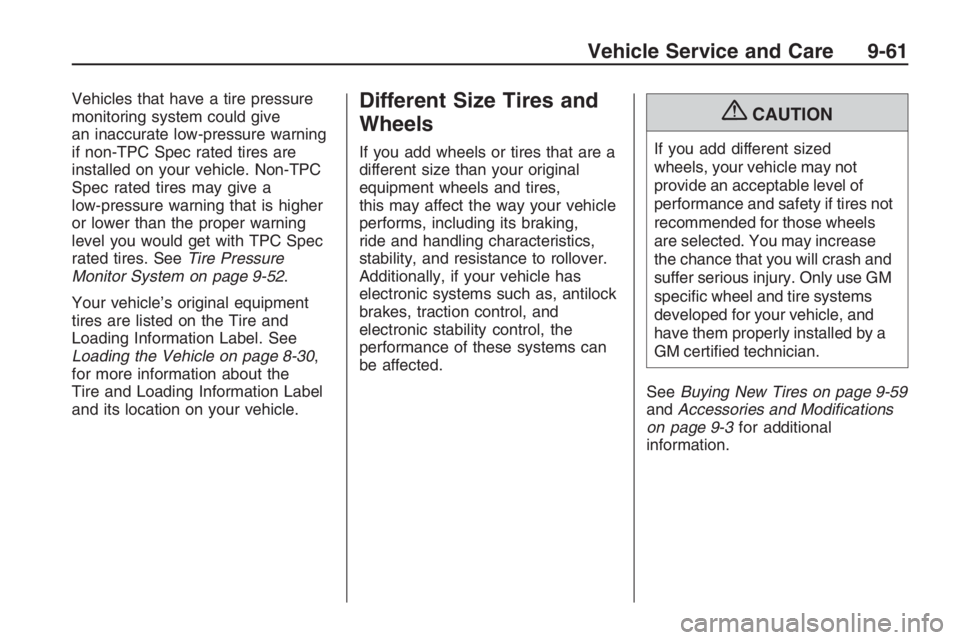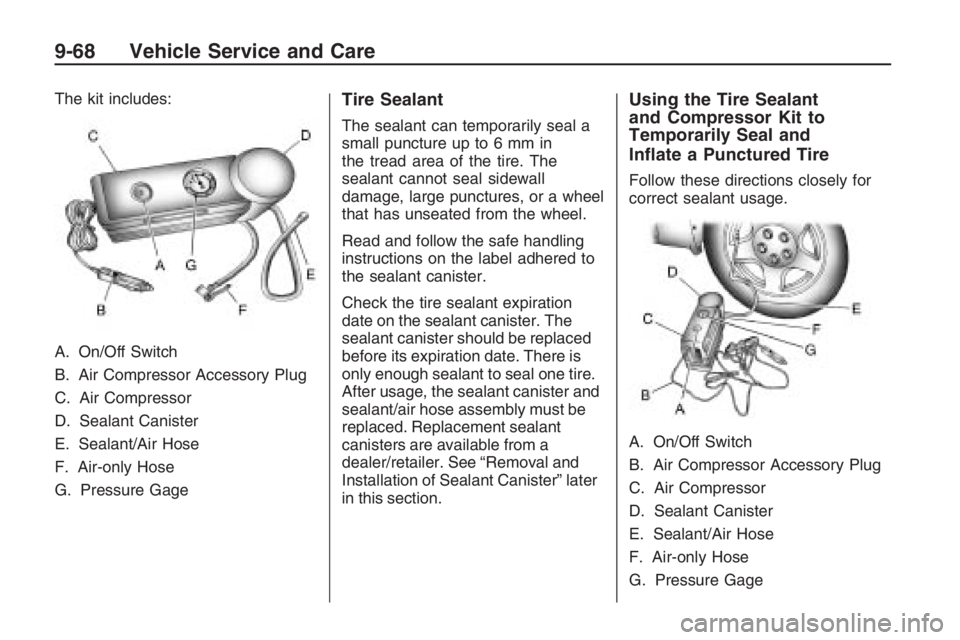2009 PONTIAC G8 tire pressure
[x] Cancel search: tire pressurePage 261 of 356

6. The driver side front indicator
lamp turns off and the
passenger side front indicator
lamp comes on to indicate
that corner’s sensor is ready to
be learned. Proceed to the
passenger side front tire and
repeat the procedure in Step 5.
7. The passenger side front
indicator lamp turns off and the
passenger side rear indicator
lamp comes on to indicate that
corner’s sensor is ready to
be learned. Proceed to the
passenger side rear tire and
repeat the procedure in Step 5.
8. The passenger side rear indicator
lamp turns off and the driver side
rear indicator lamp comes on to
indicate that corner’s sensor is
ready to be learned. Proceed to
the driver side rear tire, and
repeat the procedure in Step 5.9. After the driver side rear TPMS
sensor has been learned the
horn chirps two times. The driver
side rear indicator lamp turns
off and the TPMS sensor
matching process is done. Turn
the ignition switch to LOCK/OFF.
If no tires are learned after
entering the TPMS learn mode, or
if communication with the receiver
stops, or if the time limit has
expired, turn the ignition switch to
LOCK/OFF and start over
beginning with Step 2.
10. Set all four tires to the
recommended air pressure level
as indicated on the Tire and
Loading Information label.
11. Put the valve caps back on the
valve stems.Tire Inspection and
Rotation
We recommend that you
regularly inspect the vehicle’s
tires, including the spare tire, for
signs of wear or damage.
SeeWhen It Is Time for New
Tires on page 9-59for more
information.
Tires should be rotated every
5,000 to 8,000 miles (8 000
to 13 000 km). SeeScheduled
Maintenance on page 11-4.
The purpose of a regular tire
rotation is to achieve a uniform
wear for all tires on the vehicle.
This will ensure that your vehicle
continues to perform most like it
did when the tires were new.
Vehicle Service and Care 9-57
Page 262 of 356

Any time you notice unusual
wear, rotate the tires as soon
as possible and check wheel
alignment. Also check for
damaged tires or wheels.
SeeWhen It Is Time for New
Tires on page 9-59andWheel
Replacement on page 9-64.
When rotating the vehicle’s tires,
always use the correct rotation
pattern shown here.The compact spare tire, if the
vehicle has one, is not included
in the tire rotation.
After the tires have been rotated,
adjust the front and rear in�ation
pressures as shown on the Tire
and Loading Information label.
SeeInflation - Tire Pressure on
page 9-49andLoading the
Vehicle on page 8-30.
Reset the Tire Pressure Monitor
System. SeeTire Pressure
Monitor Operation on page 9-54.
Make certain that all wheel
nuts are properly tightened.
See “Wheel Nut Torque” under
Capacities and Specifications on
page 10-2.{CAUTION
Rust or dirt on a wheel, or on
the parts to which it is
fastened, can make wheel
nuts become loose after time.
The wheel could come off and
cause an accident. When you
change a wheel, remove any
rust or dirt from places where
the wheel attaches to the
vehicle. In an emergency, you
can use a cloth or a paper
towel to do this; but be sure to
use a scraper or wire brush
later, if needed, to get all the
rust or dirt off. SeeChanging
a Flat Tire on page 9-75.
9-58 Vehicle Service and Care
Page 263 of 356

When It Is Time for
New Tires
Various factors, such as
maintenance, temperatures, driving
speeds, vehicle loading, and
road conditions in�uence when you
need new tires.
One way to tell when it is time
for new tires is to check the
treadwear indicators, which will
appear when the tires have
only 1/16 inch (1.6 mm) or less
of tread remaining.You need new tires if any of the
following statements are true:You can see the indicators at
three or more places around
the tire.
You can see cord or fabric
showing through the tire’s rubber.
The tread or sidewall is cracked,
cut, or snagged deep enough to
show cord or fabric.
The tire has a bump, bulge,
or split.
The tire has a puncture, cut, or
other damage that cannot be
repaired well because of the size
or location of the damage.
The rubber in tires degrades over
time, even if they are not being
used. This is also true for the spare
tire, if the vehicle has one. Multiple
conditions affect how fast this
aging takes place, including
temperatures, loading conditions,
and in�ation pressure maintenance.
With proper care and maintenance
tires typically wear out beforethey degrade due to age. If you are
unsure about the need to replace
the tires as they get older, consult
the tire manufacturer for more
information.
Buying New Tires
GM has developed and matched
speci�c tires for your vehicle. The
original equipment tires installed on
your vehicle, when it was new, were
designed to meet General Motors
Tire Performance Criteria
Speci�cation (TPC Spec) system
rating. If you need replacement tires,
GM strongly recommends that you
get tires with the same TPC Spec
rating. This way, your vehicle will
continue to have tires that are
designed to give the same
performance and vehicle safety,
during normal use, as the
original tires.
Vehicle Service and Care 9-59
Page 264 of 356

GM’s exclusive TPC Spec system
considers over a dozen critical
speci�cations that impact the overall
performance of your vehicle,
including brake system performance,
ride and handling, traction control,
and tire pressure monitoring
performance. GM’s TPC Spec
number is molded onto the tire’s
sidewall near the tire size. If the tires
have an all-season tread design,
the TPC Spec number will be
followed by an MS for mud and
snow. SeeTire Sidewall Labeling on
page 9-42for additional information.
GM recommends replacing tires
in sets of four. This is because
uniform tread depth on all tires will
help keep your vehicle performing
most like it did when the tires
were new. Replacing less than a full
set of tires can affect the braking
and handling performance of
your vehicle. SeeTire Inspection
and Rotation on page 9-57for
information on proper tire rotation.{CAUTION
Mixing tires could cause you
to lose control while driving. If
you mix tires of different sizes,
brands, or types (radial and
bias-belted tires), the vehicle
may not handle properly, and
you could have a crash. Using
tires of different sizes, brands,
or types may also cause
damage to the vehicle. Be
sure to use the correct size,
brand, and type of tires on all
wheels. It is all right to drive
with the compact spare
temporarily, as it was
developed for use on the
vehicle. SeeCompact Spare
Tire on page 9-83.{CAUTION
If you use bias-ply tires on the
vehicle, the wheel rim �anges
could develop cracks after
many miles of driving. A tire
and/or wheel could fail
suddenly, causing a crash.
Use only radial-ply tires with
the wheels on the vehicle.
If you must replace your vehicle’s
tires with those that do not have
a TPC Spec number, make
sure they are the same size, load
range, speed rating, and
construction type (radial and
bias-belted tires) as your vehicle’s
original tires.
9-60 Vehicle Service and Care
Page 265 of 356

Vehicles that have a tire pressure
monitoring system could give
an inaccurate low-pressure warning
if non-TPC Spec rated tires are
installed on your vehicle. Non-TPC
Spec rated tires may give a
low-pressure warning that is higher
or lower than the proper warning
level you would get with TPC Spec
rated tires. SeeTire Pressure
Monitor System on page 9-52.
Your vehicle’s original equipment
tires are listed on the Tire and
Loading Information Label. See
Loading the Vehicle on page 8-30,
for more information about the
Tire and Loading Information Label
and its location on your vehicle.Different Size Tires and
Wheels
If you add wheels or tires that are a
different size than your original
equipment wheels and tires,
this may affect the way your vehicle
performs, including its braking,
ride and handling characteristics,
stability, and resistance to rollover.
Additionally, if your vehicle has
electronic systems such as, antilock
brakes, traction control, and
electronic stability control, the
performance of these systems can
be affected.
{CAUTION
If you add different sized
wheels, your vehicle may not
provide an acceptable level of
performance and safety if tires not
recommended for those wheels
are selected. You may increase
the chance that you will crash and
suffer serious injury. Only use GM
speci�c wheel and tire systems
developed for your vehicle, and
have them properly installed by a
GM certi�ed technician.
SeeBuying New Tires on page 9-59
andAccessories and Modifications
on page 9-3for additional
information.
Vehicle Service and Care 9-61
Page 271 of 356

Tire Sealant and
Compressor Kit
If your vehicle has a factory installed
Tire Sealant and Compressor kit,
there is no spare tire, no tire
changing equipment and no place
to store a tire.
If a tire goes �at, avoid further tire
and wheel damage by driving slowly
to a level place and stopping.
1. Turn on the hazard warning
�ashers. SeeHazard Warning
Flashers on page 4-4.
2. Park your vehicle. Set the
parking brake �rmly and put the
shift lever in P (Park). See
Shifting Into Park (Automatic
Transmission) on page 8-12.3. Turn off the engine.
4. Inspect the �at tire.
If the tire has been separated from
the wheel, has damaged sidewalls,
or has a puncture larger than a
1�4inch (6 mm), the tire is too
severely damaged for the tire
sealant and compressor kit to be
effective. SeeRoadside Assistance
Program on page 12-6.
If the tire has a puncture less than
a
1�4inch (6 mm) in the tread area
of the tire, seeTire Sealant and
Compressor Kit (V8 Engine) on
page 9-67.
Tire Sealant and
Compressor Kit
(V8 Engine)
This vehicle has a tire sealant and
compressor kit in place of a jack or
spare tire. It is located in a foam
container in the trunk. The tire
sealant and compressor kit can be
used to repair a �at tire by sealing
small punctures in the tread of the
tire. It can also be used to in�ate an
underin�ated tire. The vehicle must
be driven for �ve miles (8 kilometers)
after the tire is sealed and in�ated
to the recommended pressure to
ensure the sealant is distributed
evenly. For detailed instructions
see “Using the Tire Sealant and
Compressor Kit to Temporarily
Repair a Punctured Tire” later in
this section.
Vehicle Service and Care 9-67
Page 272 of 356

The kit includes:
A. On/Off Switch
B. Air Compressor Accessory Plug
C. Air Compressor
D. Sealant Canister
E. Sealant/Air Hose
F. Air-only Hose
G. Pressure GageTire Sealant
The sealant can temporarily seal a
small puncture up to 6 mm in
the tread area of the tire. The
sealant cannot seal sidewall
damage, large punctures, or a wheel
that has unseated from the wheel.
Read and follow the safe handling
instructions on the label adhered to
the sealant canister.
Check the tire sealant expiration
date on the sealant canister. The
sealant canister should be replaced
before its expiration date. There is
only enough sealant to seal one tire.
After usage, the sealant canister and
sealant/air hose assembly must be
replaced. Replacement sealant
canisters are available from a
dealer/retailer. See “Removal and
Installation of Sealant Canister” later
in this section.
Using the Tire Sealant
and Compressor Kit to
Temporarily Seal and
In�ate a Punctured Tire
Follow these directions closely for
correct sealant usage.
A. On/Off Switch
B. Air Compressor Accessory Plug
C. Air Compressor
D. Sealant Canister
E. Sealant/Air Hose
F. Air-only Hose
G. Pressure Gage
9-68 Vehicle Service and Care
Page 273 of 356

Do a safety check before
proceeding. SeeIf a Tire
Goes Flat on page 9-66.
Inspect the damaged tire.
The sealant cannot seal sidewall
damage, large punctures, or a
tire that has unseated from
the wheel. SeeRoadside Assistance
Program on page 12-6.
Do not remove any objects that
have penetrated the tire.
1. Place the tire sealant and
compressor kit on the ground and
unwrap the sealant/air hose (E)
from the side of the compressor.
2. Remove the air compressor
accessory plug (B) from the unit.
Do not plug the plug in yet.3. Turn the tire valve stem cap
counterclockwise to remove.
4. Attach the sealant/air hose (E)
onto the tire valve stem.
Turn it clockwise until tight.
5. Make sure the sealant and
compressor kit on/off switch (A)
is in the O (off) position.
Plug the air compressor
accessory plug (B) into an
accessory power outlet in the
vehicle. SeeAccessory Power
Outlet(s) on page 4-9for
more information.
Do not slam door or close
window on the compressor
accessory plug cord.
{CAUTION
Idling the engine in a closed-in
place or with the climate control
system off can cause deadly
carbon monoxide (CO). See
Engine Exhaust on page 8-14.6. Start the vehicle. The vehicle
must be running while using
the air compressor.
{CAUTION
Overin�ation could cause the tire
to rupture, and you or others
could be injured. Be sure to read
the in�ator instructions, and in�ate
the tire to its recommended
pressure. Do not exceed 36 psi
(248 kPa).
7. Push the On/Off switch (A) to the
I (on) position.
The kit will begin to inject sealant
into the tire. Sealant could leak
from the puncture hole until
the vehicle is driven and the hole
has sealed.
Vehicle Service and Care 9-69